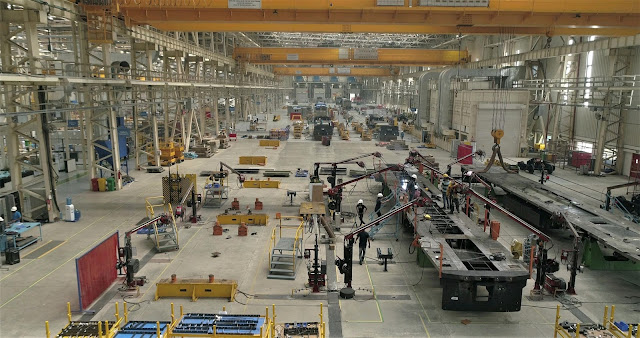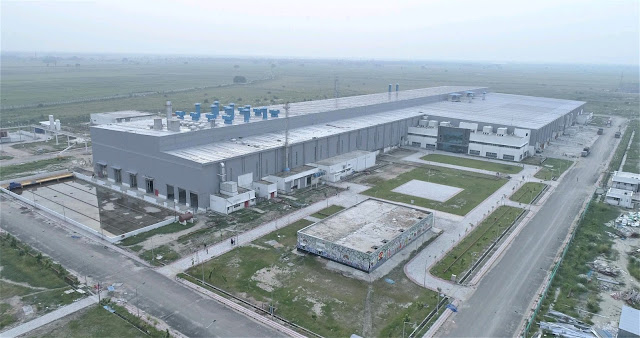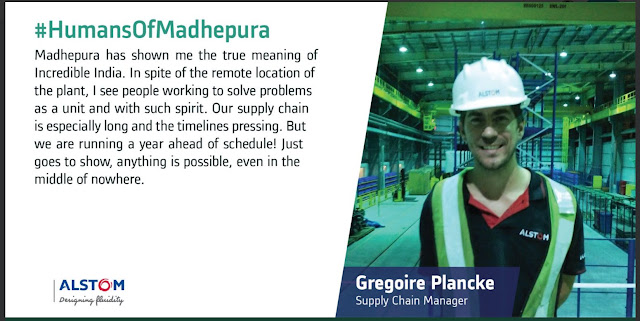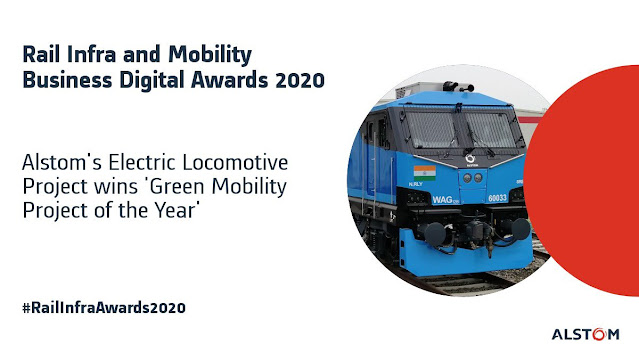Before the introduction of WAG 12, Indian Railways had taken 3 Phase technology from ABB Switzerland. The name of the project was GP 140. The details are provided in the below link.
NEW DELHI, INDIA - NOVEMBER 30: Union Minister for Finance Arun Jaitley with Minister of Railways Suresh Prabhu, JDU Leader Sharad Yadav, Ravi Shankar Prasad, Rajiv Rudy Pratap and the Ministers of State, Manoj Sinha, Kripal Ram Yadav, Giriraj Singh and other Leaders with officials of Railways, GE and Alstom during a contract agreement signing ceremony at the National Media Center on November 30, 2015 in New Delhi, India.
Indian Railways awarded contracts to General Electric Co. (GE) and Alstom to set up diesel and electric locomotive factories in Bihar at a cost of about Rs.40,000 crore.
GE Transportation CEO Jamie Miller speaks at the National Media Center on November 30, 2015 in New Delhi, India. Indian Railways awarded contracts to General Electric Co. (GE) and Alstom to set up diesel and electric locomotive factories in Bihar at a cost of about Rs.40,000 crore.
Alstom (Transportation) President Henri Poupart-Lafarge speaks during a contract agreement signing ceremony at the National Media Center on November 30, 2015 in New Delhi, India.
Minister of Railways Suresh Prabhu speaks during a contract agreement signing ceremony at the National Media Center on November 30, 2015 in New Delhi, India.
GE Transportation rolled out Indian Railways’ first Evolution Series locomotive from the paint stall, revealing the railroad's new paint scheme. The ES43ACmi (Indian Railways’ class - WDG4G) locomotive, painted in a distinctive red and yellow pattern, is the first of 1,000 diesel freight locomotives that GE Transportation will deliver to Indian Railways as part of a $2.5 billion order. The bright colors hold special meaning in India with red representing energy and yellow representing freshness.
“It is great to see Indian Railways’ first locomotive emblazoned in the railroad’s ornate paint scheme,” said Nalin Jain, President and CEO of Asia Pacific for GE Transportation. “This is a great example of the “Make in India” initiative, which will instill a sense of pride in Indians nationwide as it hauls freight throughout the country.”
The locomotive donned its new coat of paint following nearly two months of test and validation. Indian Railways’ new color scheme was completed using approximately 50 gallons of paint. The coating and paint will provide the locomotive protection in the harsh environments where Indian Railways operates.
With paint completed, GE Transportation is preparing to ship the locomotive in a few weeks. It is expected to arrive in India later this year.
The first of 1 000 Evolution Series diesel locomotives which GE Transportation is to supply to Indian Railways over 10 years was unveiled at the manufacturer’s plant at Erie in the USA on June 1.
“This new ES43ACmi locomotive is the ideal solution for Indian Railways’ modernization efforts,” said Yuvbir Singh, Vice President of Global Locomotive Operations for GE Transportation. “The design is based on our Evolution Series locomotives. It will provide greatly improved fuel efficiency and emissions compared to Indian Railways’ existing non-Evolution Series fleet.”
The ES43ACmi locomotive is one of two models GE Transportation is building for Indian Railways as part of the order. It’s a dual-cab locomotive with a 4,500-horsepower engine. The second locomotive, model ES57ACi, features a 6,000-horsepower engine. It is currently in the design phase and will begin production later this year.
These new locomotives are part of the Government of India’s Public Private Partnership program to modernize the country’s rail infrastructure.
GE Transportation is to supply 700 locos of 4 500 hp and 300 of 6 000 hp under a US$2·6bn joint venture agreement signed with the Ministry of Railways in November 2015, the largest contract ever won by GE in India. They will have Tier 1 GEVO engines.
The first 100 of the twin-cab 1 676 mm gauge locos locomotives are to be exported from the USA complete or in kit form. To meet the requirement for local production under the government’s Make in India programme, the other 900 are to produced with mainly Indian components at a factory which GE is building at Marhowra in Bihar. This is expected to be completed later this year, and will produce two locomotives per week for the current contract.
GE will also develop facilities at Roza in Uttar Pradesh and Gandhidham in Gujarat to support long-term maintenance of the fleet.
















The 1st of the emission-compliant diesel-electric locomotives has arrived at Mundra Port. Marking an important step in rail modernization.
A remarkable milestone reached today handing over the first two Evolution Series locomotives to Indian Railways and the unveiling of the Roza maintenance shed – a state-of-the-art monitoring, maintenance & training facility in the Shahjahanpur district of Uttar Pradesh.




First prototype of 6000 HP Diesel Electric Locomotive at General Electric Plant for India.
Key features of the newest locomotive
in IR’s fleet:
1.
The WDG-6G is based on GE’s Evolution series.
2.
WDG-6G is fitted with a 16 cylinder V-16 Evolution series engine. The
engine is a 4 stroke, fully turbocharged and intercooled. Power transmission to
axle is AC-AC electric.
3.
The loco has Co-Co type axle arrangement with 6 AC traction motors.
4.
The WDG-6G sports an Electronic Fuel Injection for improved fuel
efficiency and lower emissions.
5.
The locomotive is UIC 1 emission compliant. First of its kind in India.
6.
Alternator start engine is mounted on isolators for reduced vibrations.
7.
The locomotive has IGBT based traction system with individual axle
control for enhanced reliability.
8.
Multi speed, motor driven auxiliaries for optimized load control
9.
The driver’s cab has been provided with amenities like HVAC, Hot plate,
heated windshields, urinal.
10.Auto engine start/stop integrated
with APU.
11.Consolidated Control Architecture
Control System has been provided, and features such as Trip optimizer, loco
vision and cab signalling are also part of the feature-set.
12.Remote monitoring and diagnostics has
been enabled for continuous fleet health monitoring.
13.Cab frontal collision designed as per
EN12663 and AAR S580 anti-climber.
The first two diesel locomotives of 6,000 hp, manufactured by GE, arrived at the Mundra port on Sunday. They will be commissioned and tested by the Research Design and Standards Organisation (RDSO) of Indian Railways (IR) before joining the IR fleet.
Three hundred such locos will be manufactured at the GE plant at Marhowra in Bihar and will be allotted WDG-6G as the classification.
Video Links:
3. GE Marhowra Locomotive Factory, Bihar
Brain Behind GE Locomotives is an Indian from the state of Kerala.
It’s the technology, not the achievement, that really excites Kumar, a consulting engineer with GE Transportation Systems who holds more patents than any other GE employee. “I’ve worked on every new product transportation has come up with from the conceptual stage to prototype and first production,” says Kumar, 65. “I really enjoy solving problems in a slightly different way.”
Indian Railways operationalizes
India’s most powerful diesel-electric locomotive, the 6000 HP “ ANGAD ”
manufactured by GEDLPL at its modern locomotive manufacturing plant in
Marhowra, Bihar as part of ‘Make in India’ Program .
Indian Railway’s first 6000 HP
diesel-electric locomotive started its inaugural run in the service over
Northern Railway in June 2020 and the locomotives are currently in operation
over North Eastern Railway and Northern Railway. The heavy haulage capabilities
of Indian Railways will get a big boost with the start of operation of “ANGAD”.
The introduction
into service of “ANGAD” 6000HP locomotives marks
another significant milestone for GE Transportation a Wabtec Company in the
execution of Marhowra Locomotive Project having already supplied 200+
locomotives to Indian Railways.
The 1st 4500 HP locomotive entered
revenue service in October 2018. A shining example of cross functional team effort,
building local capabilities, seamless execution in strong collaboration with
Indian Railways & Govt of Bihar.
Driver's Manual WDG 6G

Alstom Locomotives in India
India’s
dream for high horse power locomotive moved closer to reality with the arrival
of the first bodyshell of 12000 HP loco from Alstom France at Kolkata port on
Wednesday.
This first-of-its-kind
high-power electric locomotive will be used to haul freight trains at twice the
existing speed by next year.
The bodyshell for the fleet
of the twin-section electric locomotives which Alstom is to supply to Indian
Railways was unloaded at Haldia, ready for delivery to the factory at Madhepura
where it will be assembled.
In
November 2015, the public transporter inked a contract with the French company
to manufacture 800 such train engines over the next 11 years in a joint venture
at the Madhepura locomotive factory in Bihar.
This is the first major FDI
(Foreign Direct Investment) project in the rail sector.
The first such locomotive,
estimated to cost about Rs 30 crore, will be assembled with components brought
in from Alstom’s factories in France and will have its trial run by February
next year.
The contract allows for the
first five locomotives to be imported, but the remaining 795 are to be
manufactured locally in support of the government’s Make in India campaign.
The total contract is worth
above three billion euro. This project includes the set-up of a plant at
Madhepura (Bihar state) and two maintenance depots at Saharanpur (Uttar Pradesh
state)and Nagpur (Maharashtra state). The delivery of the locomotives will
spread between 2018 and 2028.
The locomotive will run at
a speed up to 120 km/h.
More than 1000 workers engaged at site, over a period of 12 months, to enable commencement of production at Alstom’s first e-loco facility in India. Alstom presents a riveting story of the challenging journey, which can be viewed here:
The Railways is currently
using 6,000HP locomotives for freight services.
PROJECT GP 140
The increase in speed would
also result in improving line capacity in the rail network, a railway official
said.
As per schedule, 35
locomotives would be rolled out from the factory by 2020, 60 in 2021, followed
by 100 every year till the target of 800 is completed.
Alstom today (12-10-2017) successfully commenced production at its greenfield electric locomotive manufacturing facility in India. Located at Madhepura, in the state of Bihar, it is Alstom’s first electric locomotive manufacturing facility in the country, set to transform the heavy freight transport landscape in the country.
Commencing production on schedule, the construction of the plant is a remarkable achievement in the construction of greenfield facilities in the country. The Prima T8 (WAG12) locomotive, which will be produced in this new factory, is part of Alstom’s Prima range of locomotives and has been specially adapted for Indian network. The first two car body shells have already arrived at Madhepura and will be soon fitted and assembled at the plant. The first locomotive will be ready for roll-out early next year. The first 5 locomotives by 2019 followed by 35 locomotives by 2020, 60 in 2021, and by 100 every year till the target of 800 is completed.
A true embodiment of government’s ‘Make in India’ vision and built to the highest standards of quality and safety, this facility is part of a joint venture between Alstom (74%) and Indian Railways (26%). Spread across 250 acres, it currently employs 70 people, with plans to ramp it up at a rate of 25% every year till it reaches full capacity. The facility also aims to employ local youth, basis the required skill sets, to support socio-economic development of Madhepura.
2. http://www.knorr-bremse.co.in/en/press/pressreleases/press_detail_31040.jsp
- ABB won the order from
Alstom to supply 1600 traction transformers for 800 new electric freight
locomotives in India.
- Knorr-Bremse chosen for brake systems for 800 double
locomotives in India.
- Component suppliers include —
transformers from ABB, couplers
from Faiveley and brakes from Knorr Bremse.
- Saft’s factory in
Bibadi is supplying SRM+ batteries to provide back-up power for the control and
safety systems.
Commenting on this feat, Jean-Francois Beaudoin, Senior Vice President Asia Pacific at Alstom said,
“The E-loco project is one of the most prestigious projects for Alstom worldwide and this feat, therefore, is a commendable achievement for the entire company.
The facility is a multimillion euro investment by Alstom and is a proof of our commitment to infrastructure development in India. In order to make a difference in this market, we need local expertise, competitive manufacturing capacity and close relationships with our customers. The commencement of production at the plant is a perfect testimony to our strategy to develop and grow a localized ecosystem to bring wide reaching benefits for railways and the community at large.”
Headquartered in Bangalore, Alstom’s current manufacturing footprint in India includes its metro rolling stock manufacturing facility at Sricity, component manufacturing facility at Coimbatore with the latest addition being e-loco manufacturing facility at Madhepura.
For the e-loco project, the company is also setting-up two maintenance depots at Saharanpur (Uttar Pradesh state) and Nagpur (Maharashtra state). In addition, it also has a rolling stock and signaling design and engineering centre in Bangalore. This extensive footprint is enabling Alstom to expand its portfolio and deliver bespoke products and solutions to meet the growing needs of customers in India and other global markets.
The locomotives was developed with the support of 6 Alstom sites in France:
- Belfort for the 6 first car body shells,
- Ornans for the motors,
- Tarbes for the traction,
- Le Creusot for bogies,
- Villeurbanne for the train control monitoring systems and
- Saint-Ouen for the design.
All settled in. Alstom's first Indian made all-electric locomotive familiarises itself at it's new home base, Maintenance Depot Saharanpur.
2017, a year of firsts for Alstom
Alstom India transforms Madhepura with localized socio-economic development programs with Commitment to Community & as the motto at the heart.
WAG 12 UPDATES AS ON 20-05-2020.

WAG-12 has
two variants.
The
first model was the WAG-12A,
of which only one unit has been manufactured. This design experienced issues
with ride quality, which resulted in major modifications to the suspension and
the bogies.
The final design, now known as WAG-12B,
has been approved by the Indian Railways.
New Features on the WAG-12
·
Two units (A and B) permanently coupled to each other. Both units only
have cabs on the outward-facing ends.
·
Both units will be controlled from the working cab.
·
While both units will be provided with one pantograph each. However,
only one pantograph will be raised at a time and will feed power to both the
units through a high-tension overhead link.
·
Both units have been provided with a toilet for the crew.
·
The units are connected to each other through a vestibule and gangway.
·
A major departure from existing designs of locomotives is that high
voltage apparatus like the vacuum circuit breaker is now inside the body of the
locomotive in a special cubicle. The roof of the locomotive is almost empty
except for the pantograph.
·
This locomotive has a larger wheel diameter, compared to other freight
locomotives in service on the IR.
·
This locomotive also features the much-awaited ‘Brake Blending’
facility. If regenerative braking (AKA electric or Electro-Dynamic brake) is
applied and found insufficient, a proportionate quantum of the pneumatic brake
is applied simultaneously by the locomotive.
·
To improve reliability, almost all hardware switches and controls are
replicated on the DDU (Driver Display Unit). Thus, several functions can also
be controlled using ‘Soft Keys’.
·
A dehumidifier for air intake ensures that only dry air is used for
cooling and ventilation systems. This will improve equipment life and
insulation.
·
An automatic flap system regulates the entry of air into the
locomotive’s ventilation system and ensures uniform flow in various conditions.
·
Tube drive equipped with self-aligning roller bearings for better
suspension.
|
Axial Arrangement
|
Bo-Bo (For each of two units)
|
|
Number of Axles
|
8
|
|
Mass of Locomotive
|
180 Tons, Upgradeable to 200 Tons
|
|
Length
|
19,200 mm per unit, 38,400 mm total length
|
|
Centre-To-Centre Distance Between Bogies
|
10,200 mm
|
|
Maximum Speed
|
100 km/h, Upgradeable to 120 km/h
|
|
Continuous Speed
|
60 km/h
|
|
Max Load Haulage
|
6,300 tons, 1:150 Gradient, 60 kph for 25 Ton Per Axle Variant
|
|
OHE Voltage
|
Nominal: 22.5 kV, 50 Hz
Maximum: 31 kV
Minimum: 17 kV
|
|
Traction Power (Continuous Rating)
|
9,000 kW (12,069 hp approx)
|
|
Max Starting TE at 25t Axle Load / 22.5t Axle Load
|
785 kN / 705 kN
|
|
Braking Effort
|
563 kN
|
|
Max Braking Effort
|
79.315 kN per motor
|
|
Stopping Distance
|
900 metres: 100 kph to 0 kph
|
|
Remote Multiple Unit Operations
|
Yes, 2 Locomotives
|
|
Traction Motor
|
Asynchronous, Nose Suspended
|
|
Maximum RPM
|
2,711
|

|
WAG-12A
|
WAG-12B
|
|
Total Length
|
35,000 mm
|
38,400 mm
|
|
Bogie Design
|
Flat solebar
|
Gooseneck or handlebar shaped solebar
|
|
Traction link coupling between the bogie and body
|
Below the driving cab
|
Turned around and now provided in the middle of the body
|
|
Center to center distance between the bogies
|
Lower (8,500 mm)
|
Higher (10,200 mm)
|
Team in Madhepura
have accomplished the milestone of manufacturing its 200th BOGIE & 300th
MOTOR for India’s most powerful electric locomotive – WAG 12!

DIAGRAMS OF WAG 12:
Please Note: PICTURES ARE TAKEN FROM FACEBOOK/NEWSPAPER, ALSTOM, GE. Not My photos.




























































































































































































































.jpg)




.jpg)
.jpg)
.jpg)
.jpg)

0 comments:
Post a Comment